Wondering which tool is right for you?
When looking for a powerful automation platform, you’ve got a lot of decisions to make. How do you know which one will be the best fit for your business’s unique needs? Do you need simplistic, easy-to-use features or a tool that takes longer to learn and implement to handle the needs of an enterprise business?
Whether you’re looking for intuitive automation, CRM functionality, or in-depth reporting, both ActiveCampaign and Marketo can fit the bill. The reality is that you’re choosing between an expensive, more cumbersome tool and a flexible tool that can do whatever you need it to do without breaking the bank.
Let’s take a look at the features these platforms offer, who they’re best for, what they’ll cost you, and help you select the one that’s right for you.
ActiveCampaign: a tool for businesses of every size
Founded in 2003, ActiveCampaign is an automation platform that gives you the power to automate your marketing communications, grow your sales pipeline, and send beautiful, personalized emails to your customers. They’ve established themselves as one of the best platforms for advanced automation in the email marketing space and offer powerful features for a competitive price.
| 93.4% deliverability rate | 250+ email templates |
|---|---|
| 950+ integrations | 10k monthly email sends on Starter |
ActiveCampaign is a great fit for both small and large businesses because it offers the tools you need without overwhelming you with unnecessary extras. Its pros include advanced email marketing, powerful automation, easy-to-use features, and a smart CRM that helps you easily keep contact information up-to-date. Combining email, automation, and CRM, ActiveCampaign is a platform that any size team can use to scale their business and drive revenue.
ActiveCampaign is also #1 in email deliverability, scoring 93.4% and beating out all other email marketing platforms.

This means that more of your contacts will see the emails you send, increasing your chances of interaction (and hopefully conversion). ActiveCampaign is the go-to email platform if you care about deliverability and driving revenue. And you should, because an undelivered or lost to the spam folder email is practically useless.
When you switch from to ActiveCampaign, enjoy free 1:1 migration
Adopting a new or switching to another platform can be an undertaking, but it’s inevitable if you’re hitting certain limits with your current tool. When you sign up for an ActiveCampaign Pro or Enterprise plan, we’ll migrate your email lists, transfer your templates, rebuild your automations, and set up your forms and landing pages. All for free.
You’ll get one-on-one sessions with a real person along with resources like help articles and our community to get you set up fast.
ActiveCampaign also provides 24/7 live chat and email support, ensuring you can get help whenever you need it. Their extensive resource library includes webinars, detailed guides, and a community forum, offering a wealth of information to help you navigate and optimize the platform.
Additionally, ActiveCampaign offers one-on-one training sessions for those who prefer a more personalized touch, making it easier to get tailored guidance and support.
Marketo: enterprise-focused and complex
Marketo is a well-established marketing automation platform known for its powerful tools, especially in the B2B space and with larger, enterprise-level companies. They’ve built a strong reputation around their advanced lead management, nurturing, and account-based marketing features—making them a popular choice for businesses with longer sales cycles or complex customer journeys.
Marketo goes beyond email marketing, offering comprehensive automation features that include sophisticated workflows, lead scoring, and multi-touch attribution. They offer detailed analytics, which is ideal for companies looking to dig into campaign performance and optimize strategies over time.
| Less than a dozen email templates | 550 integrations |
|---|---|
| Basic marketing automation | Long set-up time |
While Marketo is packed with features, it’s generally geared toward teams with technical know-how or the resources to manage complex campaigns, as it can be a bit overwhelming for beginners or smaller businesses. Often, users report having to enlist the help of external support and consultants to manage the tool. Plus, it’s pricing increases exponentially as you grow.
Marketo’s advanced features can be overwhelming and costly for smaller companies or those without the resources to manage them. It may not be the right fit for those looking for a simple, user-friendly solution.
How do ActiveCampaign and Marketo compare?
ActiveCampaign and Marketo are two very different tools and naturally have some key differences. Let’s look at what real users are saying about each platform.
| ActiveCampaign | Marketo | |
|---|---|---|
| Ease of admin | 8.4 | 7.6 |
| Meets requirements | 8.8 | 8.3 |
| Ease of use | 8.2 | 7.3 |
| Ease of setup | 8.1 | 6.6 |
| Quality of support | 8.6 | 7.4 |
| Has the product been a good partner in doing business? | 8.8 | 7.7 |
| Product direction | 8.3 | 8.0 |
| Marketing automation | 8.0 | 7.8 |
Source: G2
Marketing automation: features for different needs
ActiveCampaign’s automation capabilities are incredibly advanced but simple to use. They provide hundreds of "automation recipes" you can use right out of the box and customize with your own tags, custom fields, and content. This means you can easily follow up with customers post-purchase, re-engage those who’ve abandoned carts, or send time-sensitive emails.
Their visual automation builder makes it easy to see complex workflows. You can add actions like “wait,” “if/then” logic, and triggers to shape each contact’s path.

This allows for conditional flows based on specific behaviors, like page visits or specific clicks, making it perfect for in-depth customer journeys. These workflows can include emails, SMS, site messages, and even CRM updates, all from one platform. It's perfect if you're managing both marketing and sales processes since it’s built to handle everything from lead nurturing to post-purchase follow-ups.
ActiveCampaign also allows you to A/B/C/D/E test entire workflows to see which sequence performs better. You can test different email paths, timing, or messages and compare which version drives more engagement or conversions.
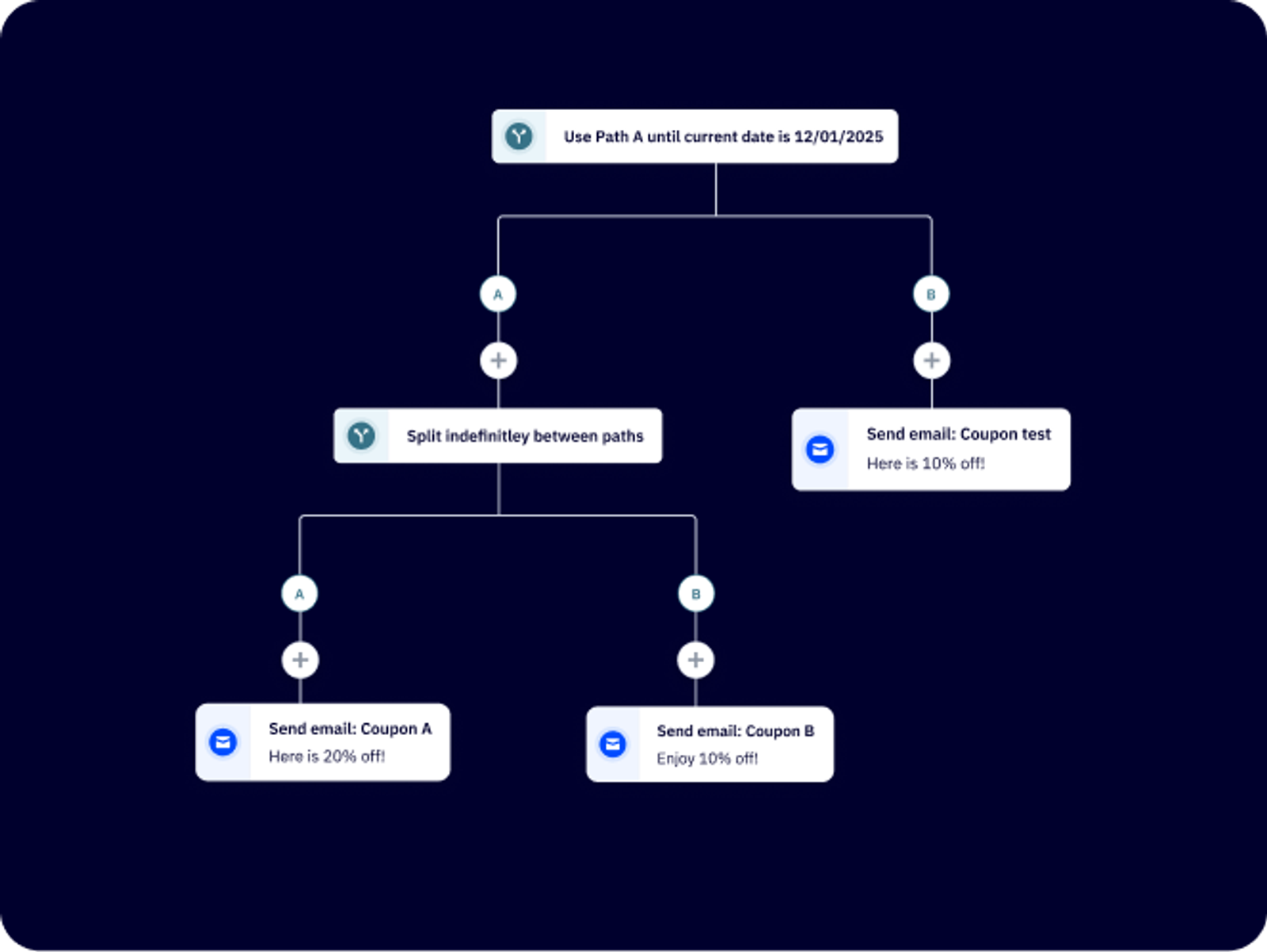
This allows you to continuously improve your automations by finding the most effective ways to guide users through the customer journey.
Triggers, actions, and goals are the brain behind ActiveCampaign’s automation. “Triggers” are the conditions that kick off a workflow—like when a lead signs up for a webinar or reaches a certain score in your system. “Actions” are what the system does in response, such as sending a welcome email, tagging the contact, or moving them into a new list. “Goals” let you set milestones within workflows, like getting a contact to register for an event.
ActiveCampaign’s event tracking tracks specific behaviors you define, like when a customer completes a purchase or fills out a form. This tracking gives you insights to tailor follow-up emails and other interactions based on real-time behavior.
Plus, site tracking features let you see what your leads and customers are doing on your website. It records actions like page visits and button clicks, so you know which content or products are catching their interest.

Finally, their sales routing helps you make sure the right sales rep connects with the right leads. Based on factors like the lead’s location, behavior, or score, ActiveCampaign can automatically assign them to a specific rep. This feature helps keep leads from slipping through the cracks and ensures that your team’s follow-ups are fast and organized, which is especially helpful for businesses with high lead volumes.
All of these features make it easy to automate personalized experiences and ensure that both marketing and sales stay aligned, giving customers a smooth, well-timed experience with your brand.
Marketo also has strong marketing automation features that help streamline and personalize campaigns. You’ll see that these features are intended for businesses with complex needs and big budgets.
Their lead nurturing feature helps you create a series of emails or messages designed to build relationships with leads over time. You can set up a workflow that automatically delivers emails based on the lead’s actions or time intervals, keeping them engaged without needing constant manual effort.
You can pair this with their lead scoring tool that automatically assigns scores to leads based on their interactions with your brand, such as attending a webinar or opening an email. Higher scores indicate stronger interest, so your sales team can focus on leads that are most likely to convert, improving both efficiency and success rates.

Marketo also offers behavior tracking. This feature tracks customer activity, like website visits, downloads, and email clicks, giving you valuable insights into what each lead is interested in. By understanding their behavior, you can tailor follow-ups to be more relevant, boosting the chances of engagement.
Finally, Marketo offers automated workflows that allow you to set up rules that determine how a lead should move through the sales funnel based on their actions or characteristics. It’s worth keeping in mind that Marketo’s workflows are more technical and can be challenging for beginners, often requiring support from experienced users or a technical team to set up and manage efficiently.
The key takeaway: ActiveCampaign and Marketo both offer strong marketing automation, but they’re built for different types of users and campaign complexity.
- ActiveCampaign is user-friendly and great for small to medium businesses; it provides intuitive workflows, site tracking, and personalization features that are easy to set up. It’s designed to keep automation accessible even without a dedicated tech team.
- Marketo is geared toward larger businesses with complex needs. Its automation features, like account-based marketing and advanced lead scoring, cater well to B2B and enterprise-level operations. Marketo’s tools are highly customizable but often require more technical know-how to leverage fully, making it a bit out of reach for teams without the resources to support a sophisticated setup
Email marketing: accessible features vs. features requiring expertise
To start, ActiveCampaign offers 250+ pre-built templates with advanced editing options and the ability to save reusable content blocks. These templates are fully customizable, allowing users to adjust layouts, colors, fonts, and content to match their branding. The drag-and-drop email designer makes this process accessible, even for those with minimal design experience.
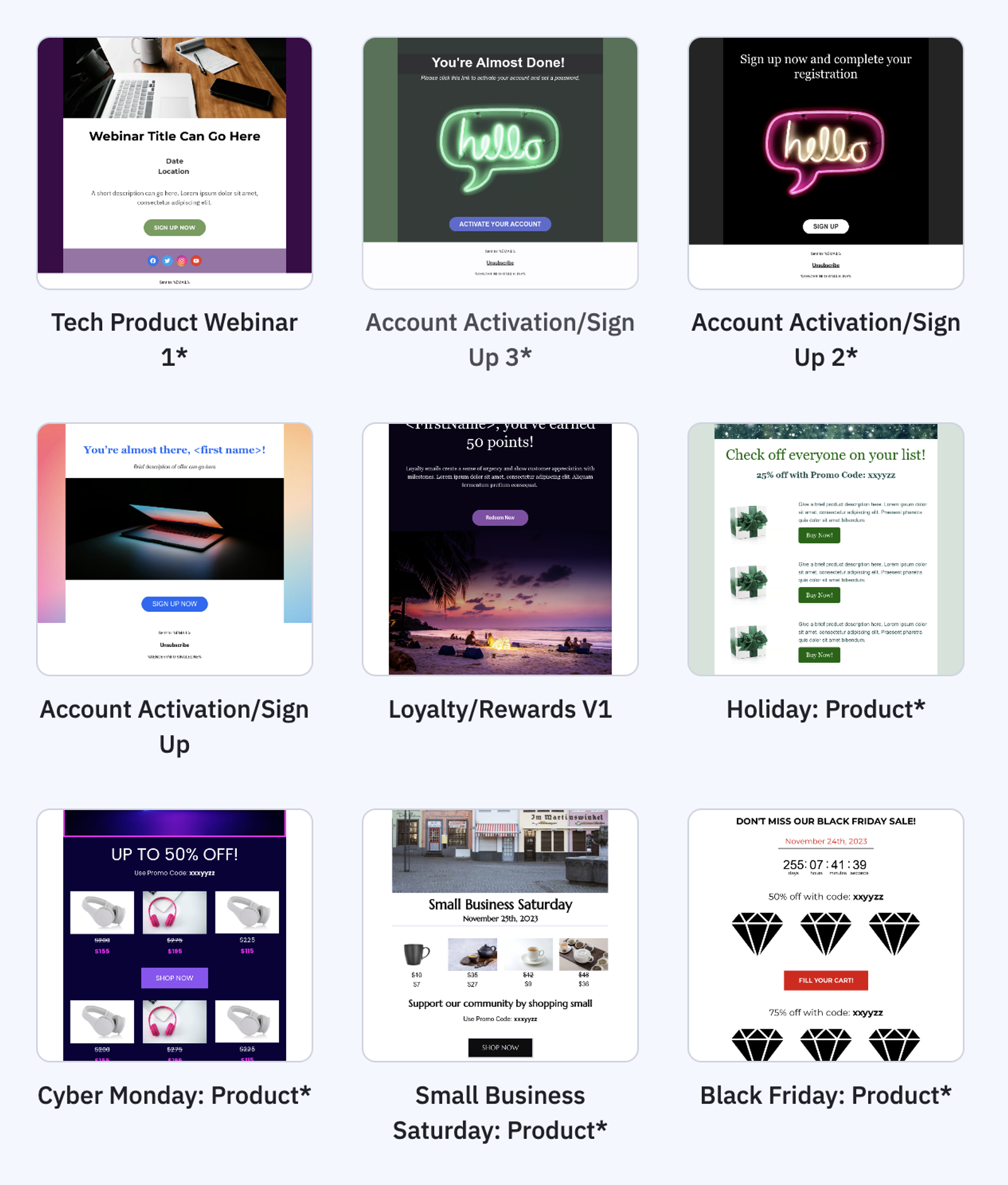
Plus, these templates can be tailored with conditional content, allowing more complex designs that adapt to each contact’s information.
ActiveCampaign is known for granular segmentation, allowing you to create highly targeted lists based on behavior, location, purchase history, and much more. You can use advanced segmentation criteria like page visits, email engagement, and even lead scores, which means you can create specific segments and reach the right audience with precise messages.
Tags allow you to label contacts based on specific characteristics or actions. You might tag contacts as “Newsletter Subscriber,” “VIP Customer,” or even “Webinar Attendee.” These tags are highly customizable and let you easily group contacts for targeted marketing.

ActiveCampaign also allows you to create custom fields that capture specific information about each contact, such as location, birthday, or preferences. You can then use this data to create more personalized messages. For example, you might create a custom field for “Favorite Product,” allowing you to tailor your emails around that specific interest.
Dynamic content lets you personalize specific sections of emails based on each contact’s details, behaviors, or tags. For instance, you can show one message to new subscribers and another to returning customers within the same email.
You’ll also get to use dynamic segments. These are lists that automatically update based on set criteria. For instance, you could create a segment of contacts who opened an email in the past month. This feature ensures that your lists are always relevant without constant manual updates.
With ActiveCampaign’s conditional content, you can personalize specific sections of an email based on each contact’s data or behavior. For instance, if a customer has shown interest in a particular product category, you can set the email to display relevant product recommendations just for them.
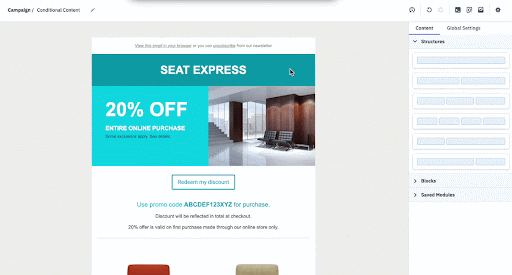
This means different subscribers can see tailored messages, images, or offers in the same email based on criteria like past purchases, location, or engagement level. It’s a powerful way to ensure each contact gets a message that feels uniquely relevant to them, boosting engagement.
Finally, ActiveCampaign excels in behavioral segmentation, letting you target contacts based on actions they take, like opening emails, clicking links, or visiting certain pages on your website. This allows for real-time personalization, so you can follow up with relevant information or offers if someone engages with a product page.
Marketo also offers a solid lineup of email marketing features designed to help businesses build, automate, and optimize their email campaigns.
The platform lets you create highly personalized emails by using data on each recipient, like their name, company, or recent interactions. Similar to ActiveCampaign, this feature goes beyond basic “Hello [Name]” personalization, allowing you to dynamically change email content based on each recipient’s preferences or past behaviors—like recommending a product based on their last purchase.

Marketo’s nurture campaigns are perfect for guiding leads through their customer journey with a series of automated emails. You can set up workflows that deliver emails over time, triggered by specific actions, like signing up for a newsletter or downloading a resource. This hands-off approach helps build relationships while keeping your audience engaged.
Similar to ActiveCampaign, you’ll get to enjoy dynamic content. Marketo’s dynamic content feature allows you to create one email that can display different messages, images, or offers depending on the recipient’s characteristics. For example, new leads might see introductory content, while returning customers see product recommendations. This way, you can target different segments without creating separate emails for each group.
To sum it up: While Marketo’s tools offer more depth, they require more expertise, making ActiveCampaign a better choice for smaller teams seeking powerful yet straightforward email marketing.
CRM: both offer advanced features
ActiveCampaign includes a dedicated CRM add-on that’s integrated into the platform.
Contact management is central to their CRM, allowing you to store and organize customer data in a central location. You can track each contact’s interactions, purchases, and engagement with your emails or website. Plus, custom fields let you capture specific information about each contact, which helps tailor your communication and create more personalized experiences.
A standout feature of ActiveCampaign’s CRM is its sales automation. With automation, you can set up triggers that respond to a contact’s actions, such as opening an email or filling out a form. This helps you create automatic follow-up emails, task assignments, or reminders.

ActiveCampaign allows you to set up automated workflows for deal management, which means that when a lead takes a certain action—like submitting a form, opening a specific email, or clicking a link—they can automatically be assigned a deal status or even moved through different stages of the sales pipeline.
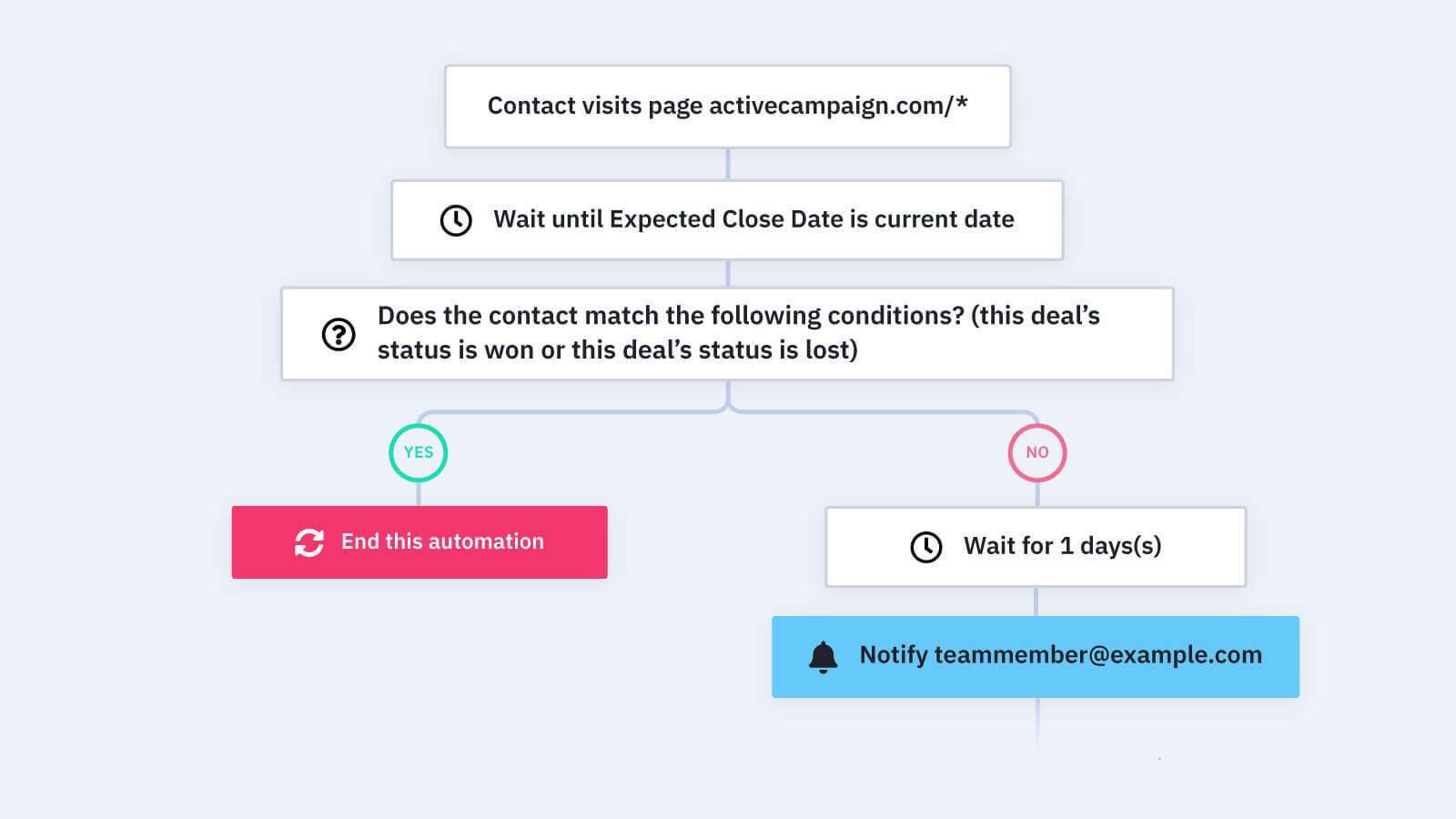
How you’d use it: Say a prospect fills out a request for a demo. You can set up an automation that automatically creates a new deal for that contact in your pipeline, assigns it to a salesperson, and sends them a notification.
By automating these steps, sales teams don’t have to worry about manually moving deals or assigning leads, which minimizes human error and ensures every lead is handled correctly.
Plus, you can use deal tracking and task management to keep your sales process moving smoothly. You can assign tasks to team members, set reminders, and track deal progress from start to finish. The activity timeline gives you a complete view of each contact's journey, including past communications, opened emails, and any sales activities. This level of detail is powerful for sales teams, ensuring they have all the information needed to close deals effectively.

ActiveCampaign also offers an extensive library of automation templates covering a wide range of marketing and sales needs, making it easy to get started with automated workflows. These templates are designed for common tasks like welcome sequences, lead nurturing, abandoned cart recovery, post-purchase follow-ups, win-back campaigns, and more.

Each template provides a ready-made structure complete with suggested triggers, actions, and conditions, so you can quickly customize them to fit your specific goals.
For instance, the welcome email sequence template helps new subscribers get familiar with your brand, while the lead scoring template automatically assigns scores to contacts based on engagement, enabling you to prioritize leads. There are also templates for customer journeys that incorporate multiple channels (like email, SMS, and site tracking), which is useful if you’re aiming for a cohesive experience across different touchpoints.
Key features of ActiveCampaign’s CRM:
- Send a notification or Slack message when a contact’s information changes or they complete specific actions.
- Track and divide up the sales outreach process between different members of your team.
- Set up automations to send relevant content to your customers based on things like order size or response times.
- Use Kanban-style boards to visualize sales opportunities.
- ActiveCampaign’s lead scoring helps you find the most promising opportunities based on your prospects’ actions and behaviors.
- The deal scoring feature gives each of your deals a numerical value so you can understand which deals are a priority.
- Use automations to create and modify deals in the CRM based on the data you’ve already collected from each contact.
Integration with the broader ActiveCampaign platform allows your CRM to work alongside your marketing automation tools, giving you a completely unified experience.
Let’s look at what CRM features Marketo offers.
Marketo offers several CRM features that help businesses manage and nurture customer relationships, particularly those with complex sales cycles.
Lead management is one of Marketo’s core features, allowing users to track leads from their first interaction through the entire sales journey. With detailed profiles on each lead, including interaction history and behavioral data, teams can gain valuable insights and ensure that leads get the right attention at every stage.
Their lead scoring feature is another standout, automatically ranking leads based on their actions, like email opens or website visits. Higher scores help sales teams prioritize leads that are more likely to convert, so no one wastes time on low-potential contacts.

The data you collect from your leads is important to understand each individual customer. Marketo’s sales insights provide real-time data on how leads engage with your content, which is particularly useful for sales teams, giving them the information they need to time follow-ups or personalize outreach based on a lead’s most recent activity.
All in all, Marketo’s CRM features are built to support larger, B2B-focused businesses with sophisticated lead management needs who want to improve coordination between marketing and sales.
The one big difference you should note:
When it comes to their CRM, ActiveCampaign offers a built-in CRM, while Marketo requires integration with an external CRM, like Salesforce, for full CRM functionality.
This makes ActiveCampaign a more complete option for businesses looking for an all-in-one marketing and sales solution, whereas Marketo is best for larger businesses that already have a dedicated CRM and need advanced marketing features to integrate with it.
AI features: one platform offers more
ActiveCampaign has AI features that make content creation and automation easier. It helps you write emails that connect with your audience by offering AI-driven suggestions for content and personalized recommendations. Plus, it can suggest the best times to send emails and different content options based on how people have engaged with your emails in the past.
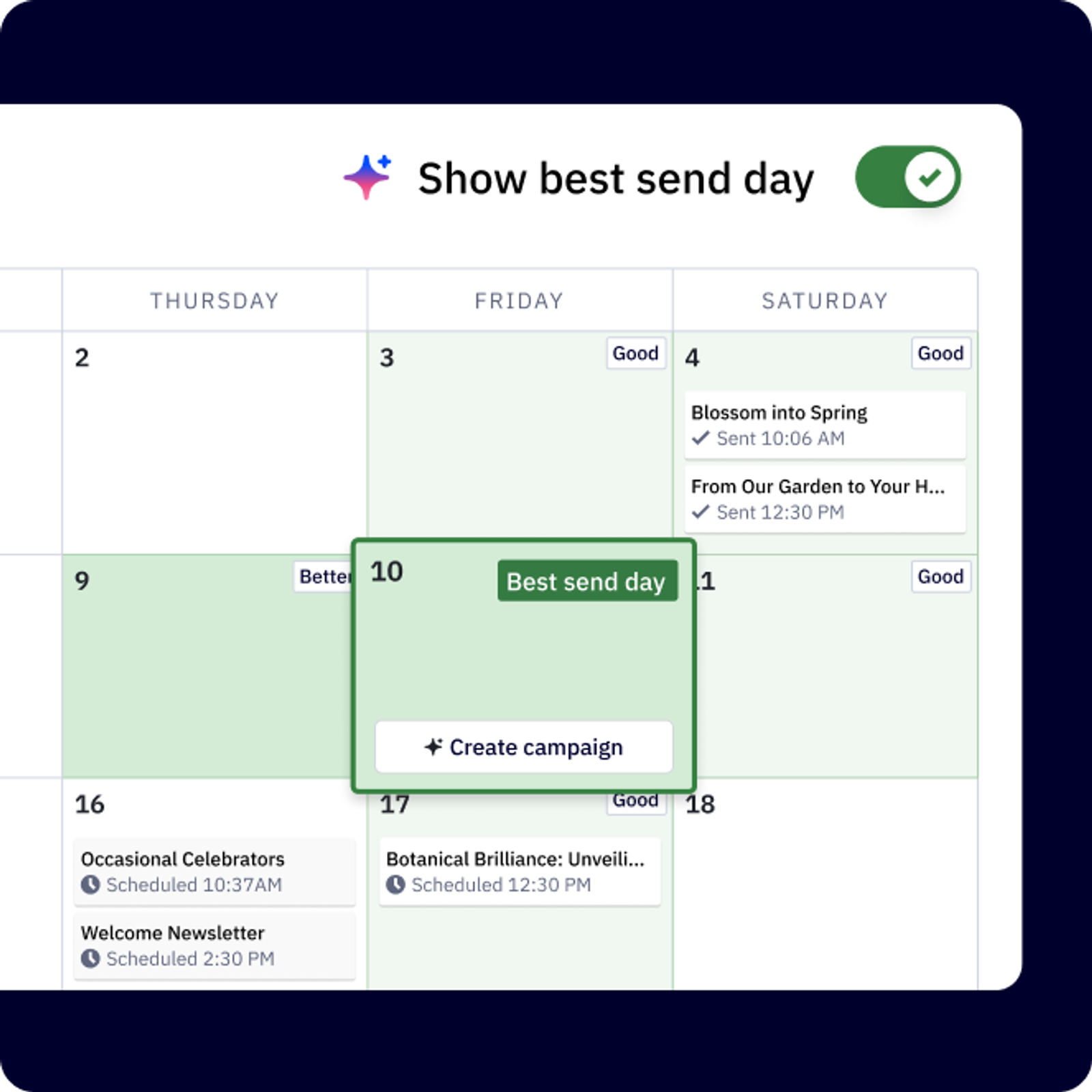
On the automation side, ActiveCampaign uses machine learning to provide actionable insights and predictive automation, allowing you to set up workflows that adapt to customer behavior. This means you can generate entire automation journeys using AI with a sentence-long prompt.
ActiveCampaign’s predictive content uses machine learning to tailor email content automatically based on each contact’s past behavior. This way, contacts see the content most likely to resonate with them, improving relevance without extra manual work.
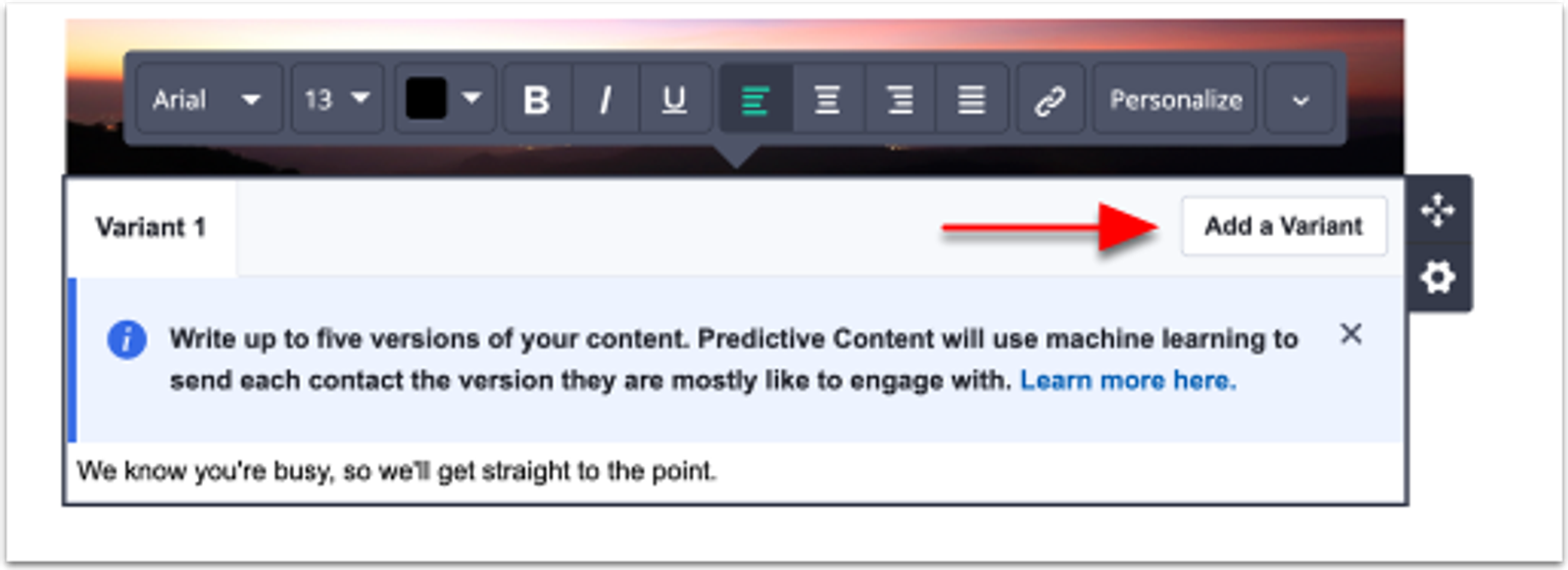
This is especially useful for large, diverse contact lists where different segments may respond best to unique types of content.
You can pair it with their predictive sending feature that uses AI to analyze each contact’s past engagement and determine the best time to send an email. Instead of a one-size-fits-all approach, predictive sending customizes delivery times for each contact to increase the chances of an open, whether they’re most likely to check their email in the morning, afternoon, or evening.
This feature can really boost open rates and engagement since emails land in inboxes when recipients are most active. It’s a great tool for businesses looking to optimize timing without manual scheduling, helping campaigns perform better with little extra effort.
In ActiveCampaign, you can use the AI Brand Kit to import your company colors, fonts, images, and logos so that every email you send out is on brand. This saves you hours of design time and ensures you maintain a unified look across all marketing campaigns.
Watch this walkthrough of ActiveCampaign’s AI Brand Kit.
Marketo offers a range of AI features that help you reach the right people with the right message. Their predictive content tool uses AI to look at how each customer interacts with your content and then suggests the best content to show them next. For example, if a customer shows interest in a certain product, predictive content will display related information or products they’re most likely to engage with, making every interaction more relevant.
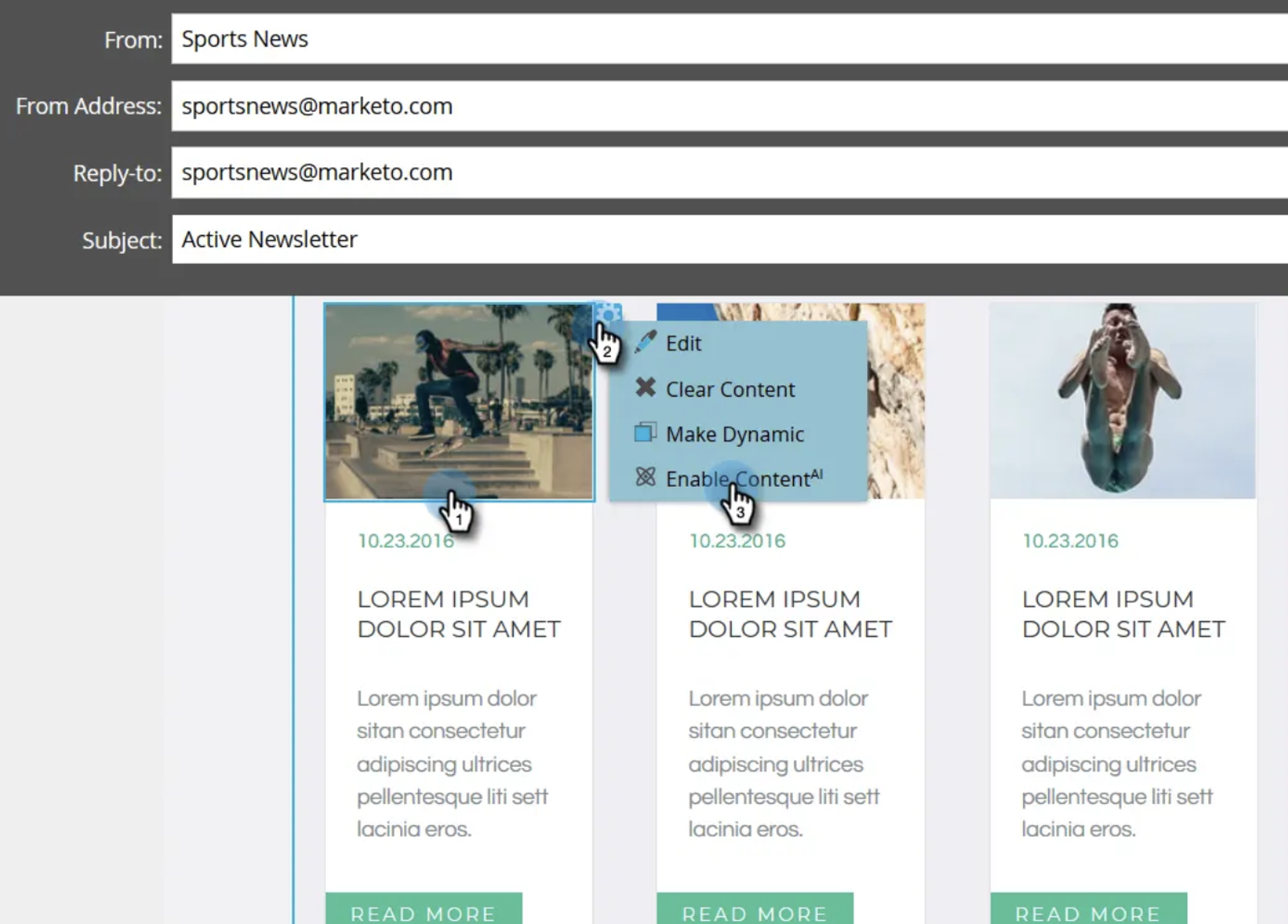
Marketo also offers predictive audience targeting that analyzes patterns in customer behavior to find which groups of people are most likely to respond positively to your marketing. Instead of guessing which leads to focus on, you can use this feature to reach out to those who are most likely to buy, saving time and improving results.
Once you’ve captured a lead, use engagement scoring to give each lead a score based on their actions—like opening emails or visiting your site. Higher scores mean a lead is more interested, so you can prioritize follow-ups with those who are most engaged and ready to connect.
Overall, Marketo offers a slew of useful AI features that allow marketers to fine-tune their campaigns and personalize each step. In comparison, ActiveCampaign has more to offer here, so it’ll depend on how much you plan to use AI functionality in your next marketing automation platform.
Integrations: 950+ vs. 550
In ActiveCampaign’s app marketplace, you’ll find 950+ apps that integrate with various tools and platforms, including CRM systems, e-commerce platforms, and other marketing tools. It supports connections with popular services like Salesforce, Shopify, WooCommerce, and hundreds more.
Marketo offers over 550 integrations, connecting with major CRMs like Salesforce, which helps align marketing and sales teams to streamline lead management. It also connects with webinar, social media, and ad platforms, making it easy to manage multi-channel campaigns.
The platform that’s right for you will ultimately come down to which tools you’re already using and how easily ActiveCampaign or Marketo integrates with them.
Reporting: both offer powerful features
ActiveCampaign offers a range of reporting tools that give you deep insights into your marketing campaigns. One that stands out is the Marketing Revenue Report, which ties your marketing efforts directly to revenue.
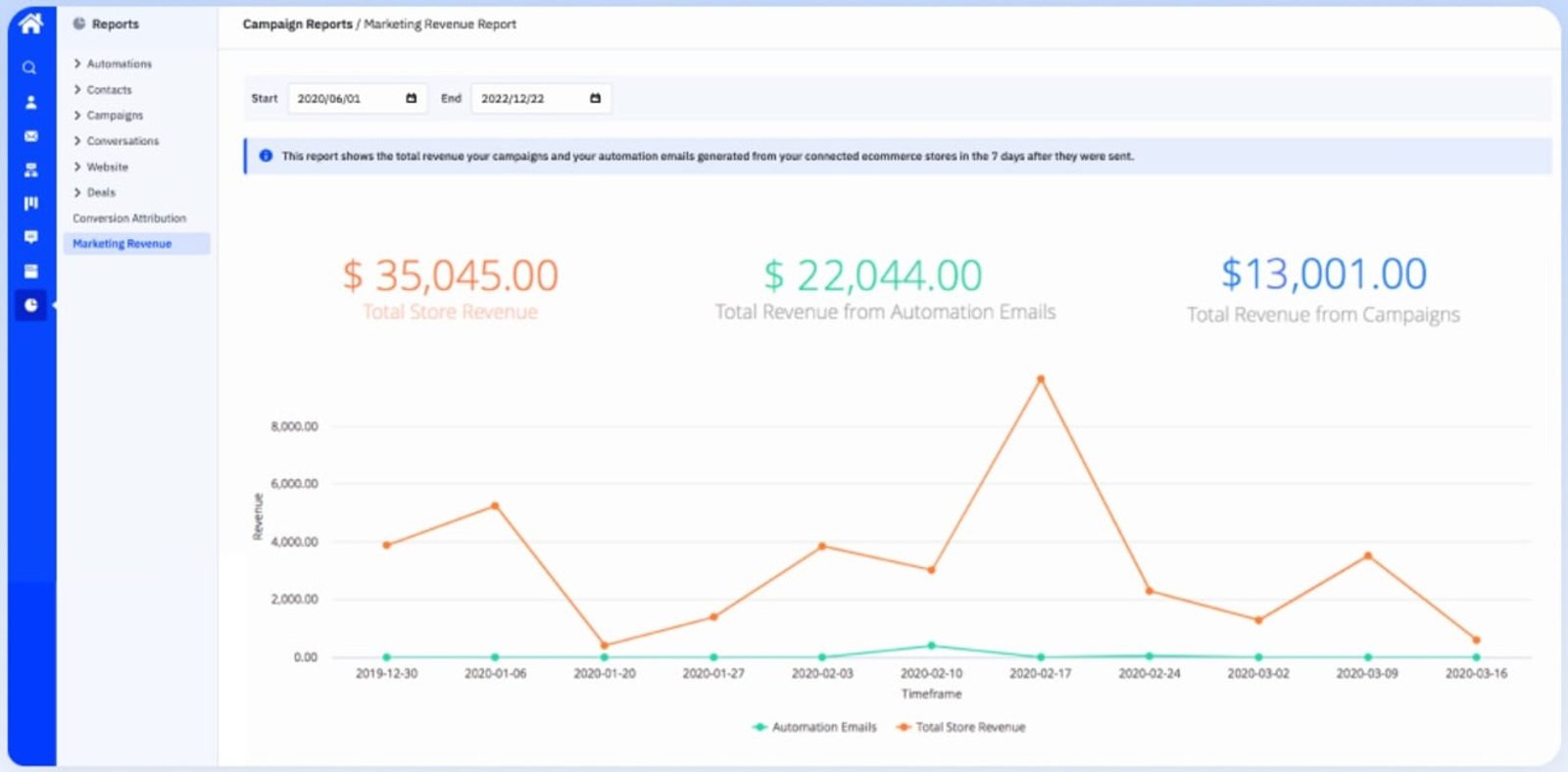
ActiveCampaign’s Marketing Revenue report helps you directly link your marketing activities to actual sales, giving you a clear picture of your ROI, a view of what’s working, and where you might need to make adjustments.
ActiveCampaign has a range of reports available, including:
- Campaign performance reports: After sending out a new email campaign, you can use ActiveCampaign's reporting tools to quickly analyze its performance. For example, if you notice a high open rate but a low click-through rate, this data can help you adjust your subject lines or calls to action for future emails. It's perfect for real-time adjustments when you're testing different messages or promotions.
- Automation reports: If you're running an automation sequence, such as an onboarding flow for new customers, you can track how each step performs. If you find that users are dropping off after the second email, you can tweak the messaging or timing. These insights allow you to refine your strategies on the fly to improve conversion rates.
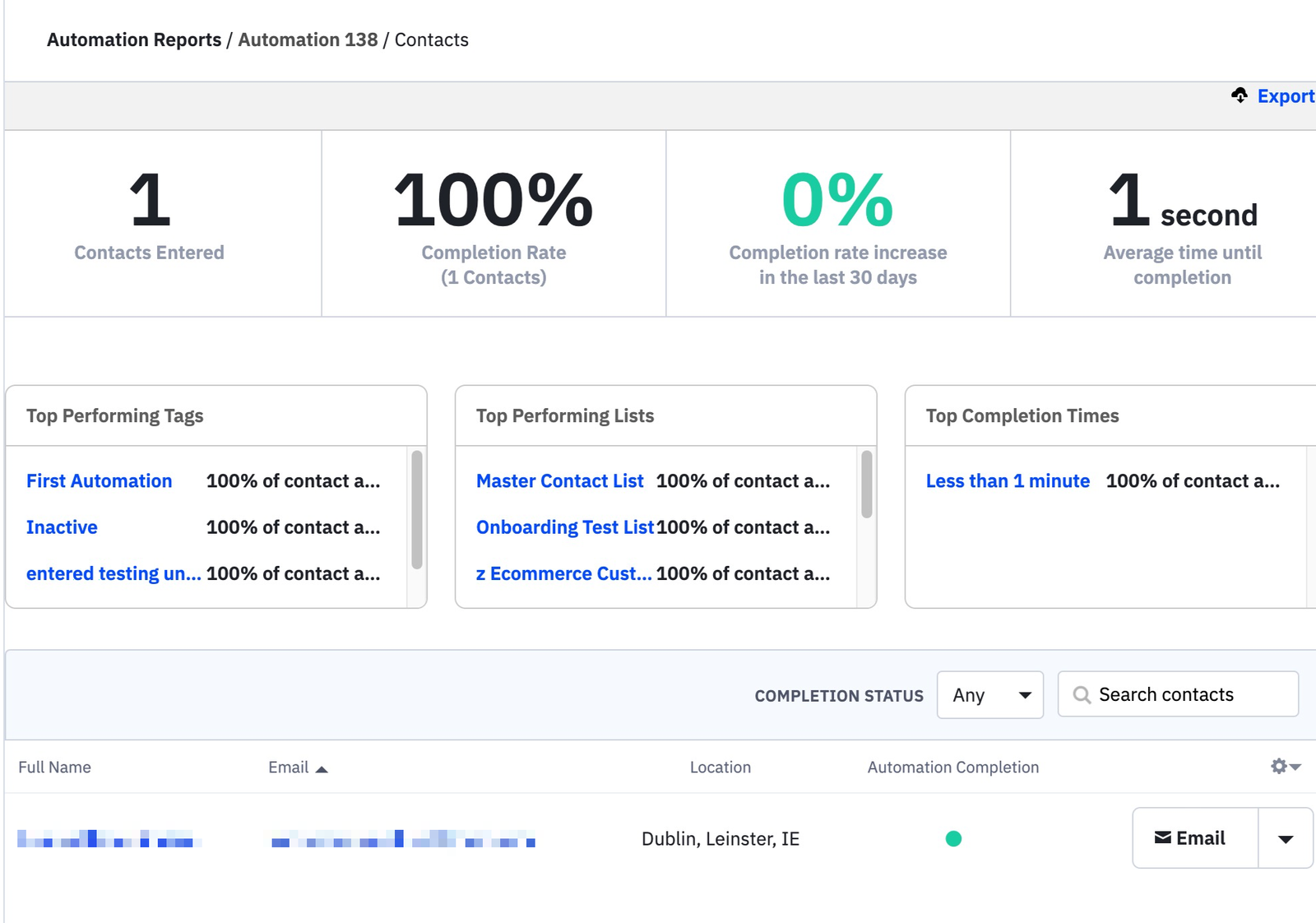
- Custom reports: Say you're interested in how specific segments of your audience (like repeat customers) interact with your emails. ActiveCampaign allows you to create reports tailored to those groups so you can dive deep into behavior patterns, optimize content for them, and track specific engagement metrics like purchase behavior.
- Real-time data: You can track the performance of an email campaign immediately after launch. This feature is ideal for marketers who want to see how their audience reacts to a particular offer and make necessary adjustments, like adjusting send times or follow-up sequences.
Key features of ActiveCampaign reporting:
- Use first-party data and ActiveCampaign’s industry expertise to score your performance and determine next steps.
- Filter out unreliable metrics and click fraud to ensure data accuracy.
- Use ActiveCampaign’s real-time reporting toolkit to spot trends, find new opportunities, and uncover actionable data about your customers.
- Predict how likely a deal is to close with win probability.
- Bring data in or send data to any app with over 900 integrations.
Marketo’s reporting features are designed to give you a detailed look at how your marketing efforts are performing, especially if you’re managing complex, multi-channel campaigns. There are a few different types of reports that they offer:
- The program performance report gives a high-level view of how your marketing programs—like email campaigns, webinars, or events—are doing. They include metrics like total members, new leads, and conversions, so you can quickly see which programs are hitting their goals and which may need adjustments.
- Their email performance reports track the success of individual email campaigns, showing stats like open rates, click-through rates, and unsubscribes. This report helps you measure engagement at a glance so you can spot trends and optimize your email strategy.
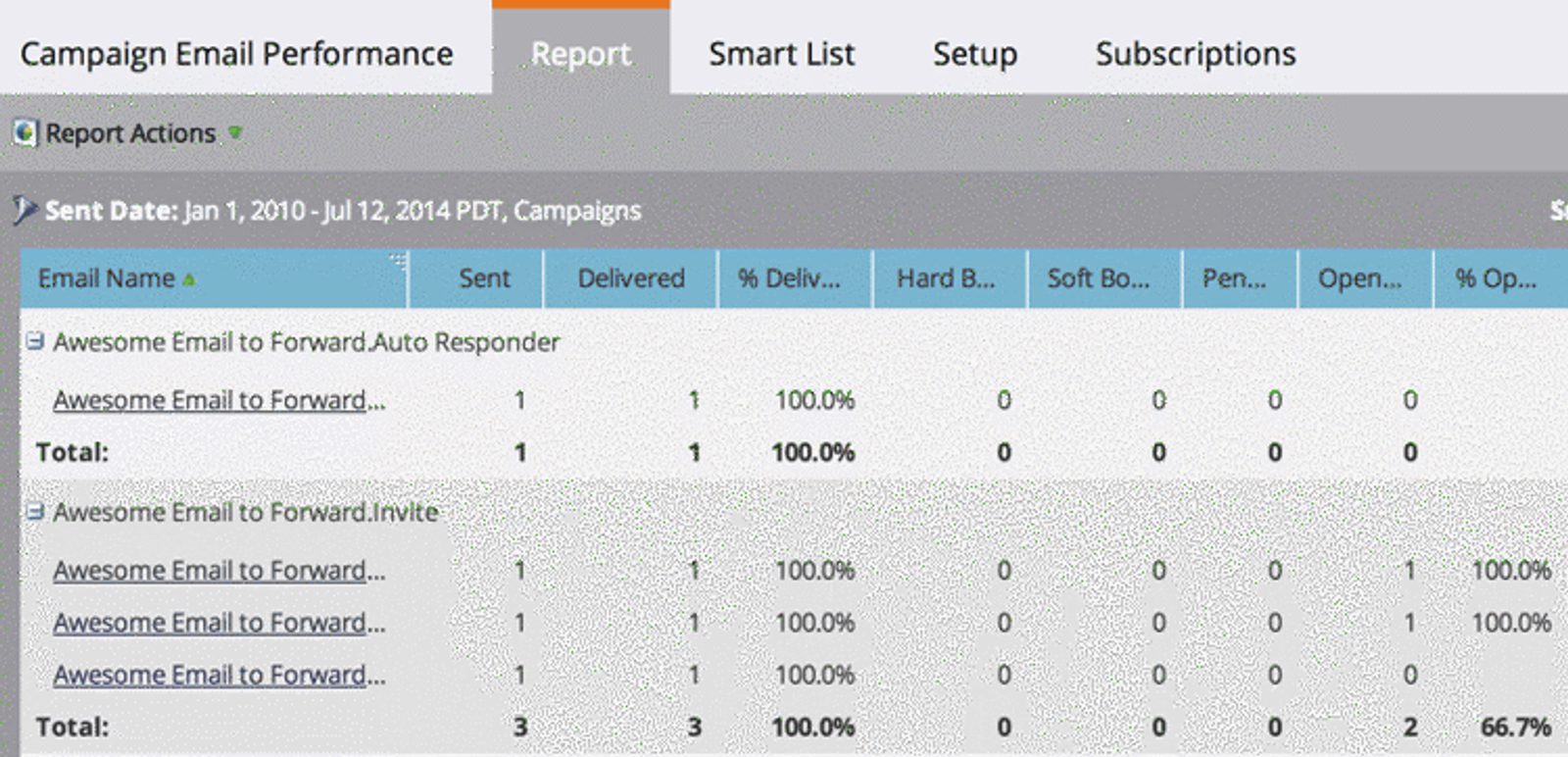
- The engagement stream performance report is specifically for nurturing campaigns, showing how different emails in your automation series perform. This report highlights where leads are engaging or dropping off, allowing you to tweak messages or timing to keep people engaged through the entire nurture path.
- Marketo’s landing page performance report tracks key metrics like form submissions, page views, and conversion rates to show how well your landing pages are performing. It helps identify which pages drive the most engagement and where improvements may be needed, such as optimizing the call-to-action or design to boost conversions.
- Their sales insight email performance report focuses on how emails perform within the sales process. It tracks open rates, click-through rates, and responses to sales emails, helping sales teams understand which messages are engaging leads.
It’s clear that Marketo’s reports are designed to track and optimize marketing performance, especially for companies that need an in-depth look at customer behavior across multiple touchpoints and channels.
Pricing comparison
ActiveCampaign and Marketo each have four pricing tiers, but it’s somewhat challenging to compare prices since Marketo doesn’t offer any pricing information on their site. Let’s look at each platform’s pricing tiers a bit closer.
Marketo pricing
The one major difference between the platforms is that ActiveCampaign has transparent pricing. You can scale up based on the number of contacts you have, so you’re able to see your unique price for the tier you choose.
Marketo doesn’t offer any pricing information, forcing you to fill out a form so a rep can reach out to you. This sets an immediate hurdle to understanding if the platform is worth the investment since you’re going in blind.

Overall, Marketo will cost you more than ActiveCampaign, which is a significant factor in choosing a tool, especially for smaller companies. The total cost of ownership typically includes implementation services and potentially dedicated team members to properly manage the platform. ActiveCampaign’s pricing allows you to start small and scale your business as you expand your marketing efforts.
Marketo’s Growth Tier promises core marketing email, segmentation, automation, and measurement. What do you actually get with this plan?
Firstly, the four tiers are Growth, Select, Prime, and Ultimate.
With the Growth plan, you get 10 users, 20k calls a day, and the following features:
| Lead and account database | Landing pages and forms |
|---|---|
| Native CRM integration | Email marketing |
| Audience segmentation and targeting | Scoring, routing, and alerts |
| Advanced dynamic content | Social marketing |
| Advanced personalization | Search engine optimization |
| Custom user roles and permissions | Paid media targeting |
| Campaign and journey automation | Campaign reporting and insights |
| Intelligent cross-channel nurturing | And secure domains |
Marketo also offers a number of add-ons to purchase if you’re on the Growth plan. These include:
- Custom data objects and fields
- Event and webinar marketing
- Interactive webinars
- Marketing calendar
- Attribution and ROI dashboards
- Predictive content
- Dynamic chat
- Target account management
- Predictive audiences
- Advanced journey analytics
- Sandbox
- Workspaces and partitions
- Marketo Measure
Moving to the Select plan, you get 25 users and 50k calls a day. It’s categorized as Marketo’s essential marketing automation and measurement plan.
The Select plan gives you access to everything mentioned, plus:
| 10 custom data objects, up to 2M records | Event and webinar marketing |
|---|---|
| Interactive webinars | Marketing calendar |
| Attribution and ROI dashboards | 50 assets for predictive content |
| And dynamic chat |
Marketo’s Prime plan promises lead and account-based marketing with journey analytics and AI personalization.
With Prime, you get everything in Select, plus:
| Unlimited interactive webinars | Target account management |
|---|---|
| Predictive audiences | Sandbox |
| Advanced journey analytics | Workspaces and partitions |
Finally, the Ultimate plan. This is Marketo’s highest tier plan with the most powerful marketing automation and premium attribution.
With the Ultimate plan, you get everything in Prime plus:
| Unlimited interactive webinars with concurrency | And Marketo Measure |
|---|
ActiveCampaign pricing
Compared to similar enterprise-level automation tools like HubSpot or Salesforce, ActiveCampaign is pretty budget-friendly for the features you get. They don’t offer a free plan (just a free two-week trial), but their Starter plan gives you access to some pretty advanced features for only $15/month.

Prices above are based on a max of 1,000 contacts.
ActiveCampaign’s entry-level pricing starts at $15/month for 1,000 contacts. This plan, aptly named the Starter plan, gives you access to multi-step marketing automation right out of the gate.
With ActiveCampaign’s Starter plan, you get access to features like:
| Email sends 10x contact limit | An AI-powered automation builder |
|---|---|
| 5 actions and triggers per automation | Site tracking |
| Email campaigns and newsletters | Limited segmentation |
| Basic and inline web forms | A/B testing on emails |
| Over 250 email templates | 900+ automation recipes |
| The ActiveCampaign Marketing CRM | Over 950 integrations, including standard e-commerce apps |
| Limited reporting and analytics |
Moving up to the Plus plan, you unlock more automation and powerful customer insights for $49/month with 1,000 contacts.
The Plus plan adds features like:
| Unlimited triggers and actions for your automations | Prospecting and retargeting ads for Google, Facebook, and LinkedIn |
|---|---|
| Web forms | Landing pages (and templates) |
| Generative AI functionality | Basic segmentation |
| Basic reporting and analytics | And revenue reporting |
With the Plus plan and up, you can add on the pipeline enhanced CRM to manage your sales automation or the sales engagement CRM that includes additional email and AI capabilities.
ActiveCampaign’s Pro plan will cost you $79/month with 1,000 contacts. With it, you unlock full omnichannel marketing automation. This is where you can truly elevate your email marketing. Your monthly email sends are 12x your contact limit, and you’ll get three users instead of one.
The Pro plan gives you access to additional features like:
| A/B testing on automations | Conditional content |
|---|---|
| Advanced segmentation, reporting, and analytics | Attribution and conversion tracking |
| Predictive sending |
The Pro plan helps you to get more granular about how your email campaigns are performing and understand what content, messaging, and offers move the needle for your business. You’ll have total control over your email cadence.
Finally, ActiveCampaign’s Enterprise plan starts at $145/month for 1,000 contacts and allows you monthly email sends 15x your contact limit plus five users.
With the Enterprise plan, you get everything previously mentioned, plus:
| Premium segmentation | Custom objects |
|---|---|
| Premium CRM integrations with Salesforce, Microsoft Dynamics, and more | Premium reporting and analytics |
| Single sign-on (SSO) | And a dedicated account team |
No matter which ActiveCampaign plan you choose, ActiveCampaign offers services like contact migration, customer enablement workshops, chat and ticket support, video tutorials, a knowledge base, and help guides to help you get the most out of the platform so you can focus on running your business.
Overall, ActiveCampaign’s pricing is much more accessible for businesses of all sizes. The features included are incredibly powerful without any extra add-on fees you’d run into with Marketo.
ActiveCampaign or Marketo: which is best for you?
The platform you choose will depend on which features above are most important to you (and which you need to grow your business).
Choose ActiveCampaign if you’re a small to mid-sized business looking for a straightforward and intuitive solution to drive marketing automation, email campaigns, and CRM needs.
ActiveCampaign is ideal for teams that need to quickly get up and running without needing technical expertise, as well as those who prioritize simplicity and value for money.
Choose Marketo if you’re a large organization or enterprise with a big budget and need in-depth data analysis and cross-channel marketing.
Marketo is best suited for medium to large businesses, particularly in B2B, that need advanced marketing automation and lead management tools to support complex sales cycles and multi-channel campaigns.
What are real customers saying about each platform?
Are customer stories too biased for you? We get it. Let’s look at a few reviews from real users.
| Pros: I appreciate Adobe Marketo Engage's comprehensive suite of marketing automation tools that allow for highly personalized campaigns and detailed customer journey tracking. Its integration with other Adobe products enhances its functionality, but the platform has a steep learning curve and can be challenging for beginners. | Cons: The most challenging aspect of Adobe Marketo Engage is its complex interface, which can be overwhelming for new users and requires significant time to master. Additionally, the platform can be slow at times, and some advanced features come with a higher learning curve, making it less accessible for smaller teams. |
|---|
| Pros: Switching to ActiveCampaign was an easy transition thanks to a beautiful interface and endless resources. ActiveCampaign is well suited to scale, too. It's small enough to be an easy on-ramp for a small company but can scale to any size. | Cons: I started on ActiveCampaign with a small company. I would have loved to get more included training or personalized deals pipelines to help get the ball rolling. Integration was incredible easy, but I would have loved more help with getting started. |
|---|
Frequently asked questions
💡 Who is ActiveCampaign best for?
ActiveCampaign is ideal for businesses that want to take their marketing to the next level with powerful automation and personalization features. It’s a great fit for small to mid-sized teams who need advanced tools to automate their marketing, segment their audience, and track detailed performance metrics.
If you're looking for a platform that offers deep customization, predictive analytics, and a visual workflow builder to create tailored customer experiences, ActiveCampaign could be a perfect match. It’s especially useful if you have a bit of experience with email marketing and want to leverage more sophisticated strategies to drive growth.
💡 Can you use ActiveCampaign as a CRM?
Yes, ActiveCampaign can be used as a CRM. It includes built-in CRM functionalities that allow businesses to manage their sales pipelines, track customer interactions, and automate follow-ups.
The combination of marketing automation and CRM in one platform helps simplify the sales process, improve customer engagement, and maintain organized records of customer data and interactions, making it easy to manage your marketing and sales in one place.
💡 What is the difference between Marketo and ActiveCampaign?
Marketo and ActiveCampaign both offer marketing automation but differ in focus and complexity. Marketo is designed for medium to large businesses, especially B2B companies with intricate sales processes. It offers powerful tools like multi-touch attribution, advanced lead scoring, and account-based marketing, making it ideal for teams with resources to manage in-depth customization and reporting.
Marketo is also tailored to companies who already have a CRM, as it integrates seamlessly with many CRM systems rather than including one built-in.
ActiveCampaign, in contrast, is a more all-in-one solution aimed at small to medium businesses. It includes an intuitive, built-in CRM, user-friendly automation workflows, and accessible email marketing tools, making it easier for businesses without a dedicated tech team to set up and manage. ActiveCampaign excels in powerful automation, site tracking, and customer engagement features that are easy to navigate, and ideal for businesses looking for a straightforward, complete marketing and sales solution.